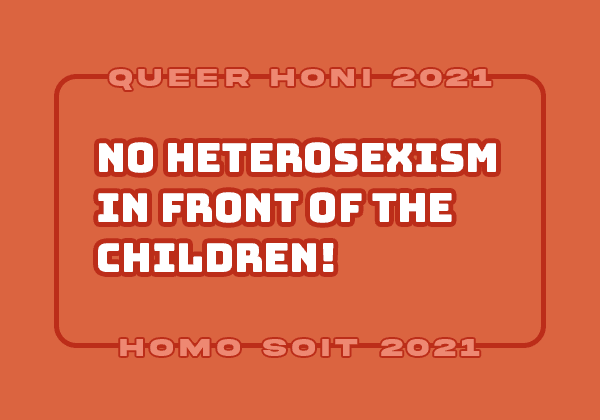Queerness has historically been painted by heteronormative narratives as explicitly sexual, dirty and shameful. Right-wing groups have seized upon these stigmas as queer communities have fought for liberation, identifying children and their rights as the easiest targets to continue their bigoted attacks against the otherwise popular ongoing movement for LGBTQIA+ equality. In the minds of these queerphobic groups, campaigners and legislators, children must be protected from so much as seeing queerness, and the very existence of queer people is seen as a threat to children’s rights. While these ideas seem to belong to a bygone era, many right-wing groups continue to argue that children must be protected from queerness and queer people today, speaking to the continuing otherness of queer people in broader society and the pervasiveness of heteronormativity.
Historically, the stigmas of immorality and corruption that have been tied to queerness have caused queer issues to be hidden from children. Margaret Thatcher’s Section 28 infamously targeted “the promotion of homosexuality” in schools, but clarified that the legislating of homosexuality was not an indicator of moral approval. This narrative has been prevalent since antiquity: homosexuality has been linked to paedophilia from its institutionalisation in the pederasty of ancient Greece. In French, pédéraste is still the homophobic slur of choice. In America, Anita Bryant’s “Save our Children” campaign is imprinted on the national memory, both because her activism galvanised the queer rights movement, whilst also impeding the handling of the AIDS crisis in the 1980s. For some queer people, the total rejection of homophobic narratives, rather than attempts to engage and counter them, was pursued as a necessary way of challenging heternormativity. Doing so further agitated resistance to the queer movement
This idea of a queer ‘threat’ to children is what is driving worldwide modern efforts to target children in a cultural war against queerness. In spite of the European Union’s condemnation, Hungary recently passed a bill banning the dissemination of content on homosexuality of gender reassignment in schools. Similarly, Poland is planning a ban preventing same-sex partners from adopting children. Various American states have adopted similar policies to these increasingly autocratic nations, with South Carolina attempting to ban LGBTQIA+ content in school curriculums and Missouri targeting the availability of queer content in the children’s sections of libraries.
Australia has experienced similar queerphobic attempts to target children. In 2015, Christian minister Mark Powell and organisers successfully lobbied for teachers in New South Wales being banned from showing the documentary Gayby Baby in classes. This debate being intensified during 2017’s same sex marriage plebiscite, where children became the nexus of debate. The Coalition for Marriage ran ads supposedly airing the concerns of parents about how same-sex marriage would change the education system. This manifested in legislation through the Safe Schools program, an eight million dollar project passed with bipartisan support, being abandoned in NSW after generating significant debate. More recently, One Nation has proposed the Education Legislation Amendment’ Bill in New South Wales. Proposed in 2020, it intends to prevent teachers from supporting trans and gender diverse children or teaching that they exist, effectively denying the existence of trans and gender diverse people. A national effort by the Liberal government is similarly proposing allowing religious schools to target queer teachers.
It would be remiss to not consider the particular targeting of trans children, and by extension the trans community, in these policies. Simultaneously arguing that trans children are a threat – often through a trans exclusionary radical feminist (TERF) lens –and that trans children are confused and helpless, legislators have prosecuted various rights limitations from preventing gender affirmation treatments or banning trans participation in children sports. These attacks rip away trans people’s identity, yet are unfortunately a continuation of the narrative that queerness exists as a ‘mental illness’, which evidently still has cultural currency in the way children are viewed as ‘confused’.
Worldwide, this organised right-wing effort can broadly be considered a reactionary effort to sustain a waning cultural war. Right-wing groups seek to coopt fears regarding the safety of children – fears that we all have – to justify stripping queer kids of their identies under the guise of protect cis-het children. Queer children are already marginalised by social inequality and stigma; queer kids are twice as likely to have experienced suicidal thoughts than their peers, with charity Just Like Us finding that over three quarters of trans youth have experienced suicidal thoughts, along with eighty-nine percent of black queer people. The idea that children are endangered by queerness only worsens the isolation and lack of agency over identity that is driving these numbers, fighting only against the imaginary threat of queerness.
The sum of this is the reiteration of the need for the queer movement to re-commit to challenging the marginalisation that queer people continue to face, despite recent progress in the form of legal rights for same-sex couples. In the sense that heteronormative norms and structures within institutions such as schools continue to cause this marginalisation, challenging heteronormaitivity through detaching queerness from morality will stop attempts to isolate children from seeing queer content, as there will be nothing to protect them from.





